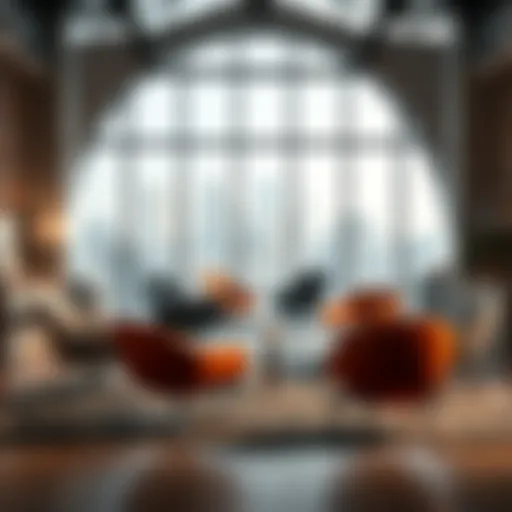Maximizing Small Spaces with Multifunctional Furniture


Intro
In today’s fast-paced world, small living spaces are becoming the norm rather than the exception. From cozy city apartments to compact houses, maximizing every square inch is essential. As homeowners and design enthusiasts, we must adapt to these challenges and turn our limited spaces into functional, stylish havens.
Multifunctional furniture can be the secret ingredient to achieving this. Think of it as a Swiss Army knife for your living room; one piece can solve multiple problems, seamlessly integrating into your decor while offering versatility. This article takes an in-depth look into the types of furniture that can elevate your limited space, blending practicality with aesthetic pleasure.
Furniture Styles and Trends
Understanding furniture styles and trends is key when it comes to selecting multifunctional pieces. They should not only fit into your space but also reflect your personal style and serve more than one purpose.
Exploring Popular Furniture Styles
Multifunctional furniture comes in various styles, each designed to serve distinct needs while enhancing the visual appeal of a room. A few popular styles include:
- Scandinavian: Characterized by simplicity and functionality, Scandinavian furniture often features clean lines and lots of natural elements. A prime example would be a coffee table with hidden storage that suits both a minimalist and a practical approach.
- Industrial: Exposed metal and rugged surfaces define the industrial look. A dual-use bench that can serve as both a seat and a storage unit fits perfectly within this trend.
- Modern Rustic: This style marries comfort with elegance. A rustic sofa that converts into a guest bed captures the essence of this trend beautifully.
- Mid-Century Modren: This style showcases clean lines and functional design. A classic example is a side table that also acts as a step stool, providing utility without compromising style.
Identifying which style resonates most with you will greatly influence your choices.
Understanding Current Design Trends
Keeping an eye on current design trends can help in choosing pieces that won’t go out of style soon. Fusion trends, such as blending vintage finds with modern functionality, have gained momentum. Eco-friendly materials and sustainable practices are also trending; furniture that serves multiple purposes without adding to environmental waste is highly sought after.
Here are some noteworthy trends to consider:
- Modular designs that can be reconfigured for various uses, like sectionals that can be expanded or reduced based on your needs.
- Transformative pieces, such as a foldable dining table that can double as a desk, showcasing the flexibility needed in tight spaces.
- Accent furniture that can hold multiple functions, like an ottoman that serves both as a footrest and a storage unit.
Practical Tips for Furniture Selection
Finding the perfect multifunctional furniture requires intentionality. Here are some practical tips for making informed decisions:
Factors to Consider When Choosing Furniture
When selecting multifunctional furniture, certain factors should top your priority list:
- Size and scale: Ensure the furniture fits comfortably in your space without crowding it. Oversized pieces can quickly overwhelm small rooms.
- Durability: Look for materials designed to withstand wear and tear while maintaining their appeal. High-quality wood, sturdy metals, and durable fabrics need to be considered.
- Ease of use: Furniture that is difficult to operate—like a murphy bed that takes half an hour to set up—is more likely to go unused.
How to Measure and Optimize Space
Choosing the right furniture without proper measurements is like sailing a ship without navigational tools; it's bound to end in chaos. Here’s how to get it right:
- Use a tape measure: Check how much room you have to play with. Measure lengths, widths, and heights of your chosen space, taking note of doorways and windows.
- Create a floor plan: Consider mapping your space out on graph paper or a home design app to visualize placements. This makes finding the right fit much easier.
- Consider flow: Make sure that you can easily navigate around the furniture pieces without bumping into them. Leave clear pathways that allow for flow through the area.
"When space is tight, it’s not just about fitting furniture in; it’s about creating a livable, breathable environment."
By following these practical tips, one can not only select the right pieces but also ensure a harmonious living space where style meets functionality.
Understanding Multifunctional Furniture
Multifunctional furniture embodies the idea of maximizing utility while minimizing space consumption, especially in settings where square footage is limited. This form of furniture not only serves its primary purpose but can transform to fulfill other roles, thus paving the way for a more adaptable living environment. When navigating urban landscapes or compact homes, understanding multifunctional furniture becomes crucial for homeowners, interior decorators, and designers alike.
Definition and Purpose
At its core, multifunctional furniture refers to pieces that have more than one function or can serve multiple purposes. Think of a stylish coffee table that doubles as a storage unit, or a sleeper sofa that converts seamlessly from an inviting seating arrangement into a cozy sleeping space. The primary aim of multifunctional furniture is twofold: it attempts to enhance space efficiency while maintaining aesthetic appeal. A well chosen piece can influence not just how a space looks but also how it feels.
The purpose is clear: to create functional living spaces where every square inch can contribute to the overall comfort and usability of the environment. This concept takes on additional importance as living areas decline in size in many urban environments, making smart design choices integral to comfortable living.
Historical Context
The roots of multifunctional furniture can be traced back to the mid-20th century when designers began to experiment with the concept of adaptability. Post World War II, as people moved into smaller homes or apartments, the need for efficient use of space became apparent. Scandinavian design, particularly, has heavily influenced this movement, promoting simplicity and functionality while offering innovative solutions.
Incorporating ideas from the likes of Charles and Ray Eames, multifunctional pieces started gaining traction, evolving from mere practicality to objects of desire. Projects such as the famous konvertible sofa of the 1970s, which could morph between various forms, illustrated this shift. Consequently, design has steadily moved towards creating pieces that speak both to function and form, allowing homeowners to enjoy beauty without compromising on usability.
Trends in Multifunctional Design
In recent years, an observable shift towards minimalism has paved the way for even more advancements in multifunctional furniture design. Current trends showcase an acute focus on sleek lines and simple shapes, which allow pieces to blend effortlessly into diverse decor styles. Key trends include:
- Modular Systems: Furniture that can be rearranged or expanded to suit different occasions or functions often tops the charts in trending multifunctional designs.
- Convertible Elements: Whether it's a dining table that folds down or a sofa that transforms, these designs cater to the varying demands of daily life.
- Sustainability: There is an increasing emphasis on sourcing eco-friendly materials while designing these multifunctional pieces, aligning with broader shifts in consumer preferences towards sustainability.


Each trend speaks to the dynamic relationship between space and human behavior, making it essential for those involved in design or looking to optimize their spaces to keep their ears to the ground.
"More than just furniture, multifunctional pieces represent a lifestyle shift that prioritizes flexibility without sacrificing style."
By embracing multifunctional furniture, one can navigate the constraints of minimalistic living with ease, promoting both functionality and an inviting aesthetic that reflects personal taste.
Such a nuanced understanding empowers homeowners and designers to curate spaces that are not only livable but resonate with a sense of individuality.
The Importance of Space Optimization
Space optimization is not just a trend; it's a vital consideration for anyone living in areas where square footage is at a premium. In this article, we’ll explore just how critically important it is to maximize every inch of your home while maintaining style and function. A carefully organized space can significantly enhance the quality of life, ensuring that a smaller environment feels cozy, functional, and aesthetically pleasing.
For homeowners, optimizing space is crucial in creating a comfortable living area. The right pieces of multifunctional furniture can transform a cramped setting into a haven of functionality. Let’s break down the challenges involved and the undeniable benefits of these practical solutions.
Challenges in Small Living Areas
Living in a small space often comes with its own set of dilemmas. Here are some of the typical challenges that residents may face:
- Limited Storage: Small living spaces often lack adequate storage, leading to clutter and disorganization. It’s a puzzle that can really mess with the flow of a home.
- Difficulties in Layout: Arranging furniture becomes a tricky game. What works in one corner may not in another, forcing many to compromise on functionality or aesthetic appeal.
- Feelings of Confinement: In smaller spaces, it’s easy to feel boxed in. The wrong furniture arrangement can make the area feel even smaller, causing frustration.
These obstacles are not insurmountable. Understanding these challenges lays the groundwork for solutions that not only address the deficiencies but also capitalize on the available space.
Benefits of Multifunctional Solutions
The beauty of multifunctional furniture lies in its ability to tackle these challenges head-on, providing benefits that far exceed mere aesthetics. Here are some key advantages:
- Maximized Utility: Multifunctional pieces, such as convertible sofa beds or expandable dining tables, allow homeowners to use their spaces for various purposes, whether it's entertaining guests or hosting overnight visitors.
- Space Saving: By investing in furniture that performs multiple roles, you decrease the number of items needed in your home. This naturally reduces clutter and improves the overall look and feel of your space.
- Increased Flexibility: The versatility of multifunctional furniture lends itself to easier reconfiguration of rooms. A living room can quickly shift to an office or play area without a hassle, accommodating the ever-changing needs of its inhabitants.
- Cost-Effectiveness: Considering the potential for long-term use, multifunctional solutions can be a more economical choice than buying separate pieces for each requirement. This is particularly relevant for renters or those on tight budgets.
"In small homes, every item holds significance. Multifunctional furniture acts as both a necessity and a statement piece."
Types of Multifunctional Furniture
In today’s world, where space often feels like a luxury, multifunctional furniture serves as a savior for those navigating limited living areas. The clever design of these pieces maximizes utility while subtly enhancing aesthetics. They’re not just about saving square footage; they also cater to a lifestyle that demands flexibility, comfort, and convenience. Homeowners, interior designers, and realtors alike find significant value in understanding the myriad forms multifunctional furniture can take.
Sofas and Sofa Beds
Sofas often become the centerpiece of living spaces, and when they’re also capable of transforming into beds, they take on a dual role. A contemporary sofa bed offers a stylish seating option during the day and a cozy bed for guests at night. Take, for instance, a sleek-looking sofa that seamlessly folds out into a queen-sized bed. With an aesthetically pleasing design, it doesn’t compromise on style and can suit a wide range of interior themes.
Choosing the right sofa bed involves weighing factors like mattress quality and ease of conversion. No one wants to fumble around trying to pull out a bed after a long day! Additionally, some models come with built-in storage, making them even more appropriate for cramped quarters.
Storage Ottomans
specific spaces can often feel cluttered; that's where storage ottomans make their entrance. These dual-purpose marvels serve as versatile seating, footrests, or coffee tables, while stealthily housing everything from books to blankets. They’re like the double agents of small living areas, blending functionality with style.
Consider an ottoman upholstered in a vibrant fabric that complements your color scheme. Not only does it provide comfort, but it also invites functional beauty into the room. To choose the right one, assess its storage capacity and sturdiness. Can it hold up to everyday wear and tear?
Expandable Dining Tables
Gathering friends and family around a table is a fundamental part of our social lives. With an expandable dining table, you can maximize dining space without permanently sacrificing precious square footage. These tables typically come with removable leaves or can fold out when needed, accommodating various groups, whether it’s a quiet dinner for two or a lively gathering of six.
Materials play a vital role—wood options can bring warmth, while glass and metal lend a modern edge. Think about how the table aligns with your existing décor and lifestyle. Would a round table better fit the layout of your small space?
Murphy Beds and Wall Units
When it comes to space-saving solutions, Murphy beds stand out as classics. They’re ingeniously designed to fold up against the wall, transforming a bedroom into an office or a living area during the day. They make it possible to optimize a room’s utility without permanent commitments. Many modern designs incorporate shelving and cabinetry, allowing for additional storage.
Installation is crucial—ensure the mechanism is reliable and safe. And don’t forget the design elements. A well-designed Murphy bed should look like an integral part of the room, not an afterthought.
Convertible Coffee Tables
The humble coffee table has undergone a remarkable transformation with the introduction of convertible models. These tables can change from a low coffee table to a higher surface for dining or working, showcasing immense versatility. Imagine having a chic table that elevates for those unexpected work-from-home days.
When selecting a convertible coffee table, consider its stability and ease of conversion. Some even come with hidden storage or additional features like built-in cooling trays, making them even more appealing for modern living.
Always remember that the essence of multifunctional furniture lies in marrying style with practicality, allowing you to enjoy your space fully without any trade-offs.
Material Considerations
When it comes to furnishing a space that evokes both style and efficiency, the choice of materials plays a pivotal role. Furniture isn’t just about form but also functionality and durability. Particularly in small spaces, opting for the right materials can enhance the performance of multifunctional pieces while still aligning with aesthetic desires. This section will explore the importance of material considerations and the implications of durability, functionality, and visual appeal in the context of multifunctional furniture.


Durability and Functionality
In smaller living environments where every inch counts, investing in furniture that is both durable and functional is crucial. Multitasking pieces need to stand up to daily wear and tear, especially when they serve multiple purposes. For instance, a storage ottoman might double as a coffee table and a seat, leading to increased usage.
Key Material Advantages:
- Hardwoods like oak or maple offer exceptional durability. They withstand the rigors of being moved, stored, or modified.
- Engineered wood, such as MDF (Medium-Density Fiberboard), can offer a good balance between affordability and resilience. While it may not possess the natural beauty of hardwood, its ability to mold into contemporary designs makes it a practical choice for various functionalities.
- Metal components can enhance stability in designs like Murphy beds or modular shelves, providing strength without becoming bulky.
Furthermore, materials that are easy to clean, like leather or vinyl, can help maintain a fashionable yet practical living space. Durability isn't merely about longevity; it also plays a role in safety. For example, furniture that can resist scratches and stains reduces the chances of accidents and ensures ease of maintenance, making it a win-win for small space dwellers.
Aesthetic Appeal
While durability and functionality hold significant weight, the visual allure of multifunctional furniture cannot be ignored. The right materials can evoke a sense of style that complements the overall decor, creating an inviting atmosphere even in compact areas.
Visual Impact Considerations:
- Natural Fibers: Incorporating pieces made from natural materials like rattan or bamboo adds warmth and texture to a room. They can easily blend in with various styles, from rustic to modern.
- Finishes: The choice of finishes—matte, glossy, or even textured—plays a role in how light reflects off surfaces, affecting the perceived space. Light colors can make a room feel larger, while darker hues can add depth and sophistication.
- Sustainability: Many consumers are gravitating towards eco-friendly options. Wood sourced from sustainable forests or recycled materials often not only looks great but appeals to the environmentally conscious homeowner or designer.
You might say that aesthetics combined with clever material choices is about enhancing a sense of living space. For example, a sleek, modern sofa bed in a light hue can make a studio feel more expansive while fulfilling nightly sleeping needs. Ultimately, the choice of materials can be the difference between a cluttered feel and an elegantly curated atmosphere.
"Incorporating the right materials in multifunctional furniture design not only supports practical use but also uplifts the essence of small living spaces."
By focusing on materials that offer durability and aesthetic appeal, homeowners can ensure that their multifunctional furniture not only serves its purpose but also adds to the charm of their living area. This strategic approach to material selection empowers residents of smaller spaces to create environments that are both functional and visually pleasing.
For more insights on selecting materials and designing multifunctional furniture, you may refer to resources like Wikipedia or consult design forums on platforms like Reddit.
Careful material consideration isn’t just about making do with what’s available; it’s about choosing what truly enhances every square inch of your living space.
Innovative Design Solutions
Understanding the need for innovative design solutions in small spaces is akin to learning the art of juggling. It requires skill and creativity, ensuring that every piece in the room serves a purpose without feeling cluttered. Innovative design isn’t just about aesthetics; it’s about turning limitations into opportunities to create functional, stylish environments. The exciting part? Such solutions pave the way for maximizing square footage while accommodating the modern lifestyle that thrives on flexibility.
Creative Storage Options
When space is scarce, the last thing you want is clutter piling up. That's where creative storage options come into play, acting as guardians against chaos. Think of a coffee table that doubles as a full-scale storage unit or floating shelves that give a little flair without taking up ground space—these ideas serve both form and function.
- Under-Bed Storage: Utilizing the space beneath the bed can yield some valuable hidden compartments. Storage bins or drawers can house out-of-season clothing and extra linens, keeping the bedroom neat.
- Furniture with Built-In Storage: Sofas with hidden compartments and benches that lift to reveal a storage space can hold anything from books to board games, eliminating the need for additional furniture pieces which might crowd the room.
- Wall-Mounted Solutions: Consider wall-mounted hooks or racks for everything from bicycles to kitchen utensils. It keeps items accessible yet off the floor, showcasing them like décor.
Choosing the right storage solutions not only frees up valuable real estate but adds an element of charm, contributing to the overall design aesthetic.
Modular Furniture Systems
Moving beyond the mundane, modular furniture systems are a treasure trove for anyone looking to maximize their living areas. These systems are composed of several units that can be rearranged or repurposed according to one’s needs. Like a puzzle, they fit together, allowing homeowners to customize their settings dynamically.
- Versatility: Unlike static furniture, modular systems can be altered easily. A sofa could morph into a sectional or lounge setup, adapting to the number of guests.
- Space Efficiency: Modular pieces can be broken down and stored when not in use. A shoutout to studios where space isn’t just a luxury but an artistry in itself.
- Design Freedom: With various styles, colors, and materials available, users can mix and match to find a combination that speaks to their unique personality.
"Design is not just what it looks like and feels like. Design is how it works." – Steve Jobs
Ergonomics in Small Spaces
In today’s fast-paced world, the way we design our living spaces has become paramount, especially when it comes to maximizing the use of limited areas. Ergonomics, often recognized as the science of designing the workspace to fit the user, plays a crucial role in small living spaces. When we consider ergonomic principles, we are not merely looking at aesthetics; rather, we’re focusing on creating environments that foster health, comfort, and accessibility throughout one's everyday life.
Health and Comfort
When space is at a premium, comfort should not take a back seat. The importance of ergonomic furniture cannot be overstated as it relates to the well-being of individuals living in smaller spaces. Pain from poor posture is a common issue, especially in compact environments where furniture often seems cramped or inadequate.
Here are several aspects illustrating why health and comfort top the list:
- Posture-Friendly Designs: Multifunctional furniture designed with proper alignment in mind can alleviate stress on the body. Awell-designed chair or sofa promotes good posture, helping to prevent backache and long-term issues that come from sitting in poor positions for extended periods.
- Adjustable Features: Many contemporary pieces offer adjustable heights or convertible mechanisms, catering to the diverse needs of users. For example, a folding desk that can be raised for standing work can contribute significantly to reducing fatigue.
- Material Choices: Selecting furniture made from breathable fabrics and supportive structures enhances overall comfort. Cushions with higher density foam can offer more support while allowing for activity throughout the day without sacrificing comfort.
Ultimately, a focus on health translates to improved productivity and general life satisfaction, debunking the myth that small living must mean sacrificing comfort.
Accessibility Considerations
Accessibility is a nuanced facet of ergonomics, particularly important for diverse populations including seniors, individuals with disabilities, or even anyone experiencing temporary mobility challenges such as a sprain or recovery from surgery. Compact spaces need to be navigable without the risk of accidents or injury. Here’s how thoughtful design can make a world of difference:
- Clear Pathways: Furniture placement that allows for easy navigation is critical. Ensuring sufficient space between furniture, such as couches and coffee tables, can avoid spills or trips that might lead to injury.
- Flexible Arrangements: Modular or movable furniture pieces allow for quick reconfiguration based on immediate needs. This adaptability can transform a narrow living area into a temporary workspace, dining room, or relaxation zone in just a few moments.
- Grip and Stability: For instances where mobility aids or support is involved, furniture with stable structures and added grips will provide the necessary support while aiding accessibility. For example, furniture designed with rounded edges helps enhance safety by minimizing sharp corners that might be hazardous in low-visibility circumstances.
"An accessible environment not only enhances functionality but also contributes massively to the user’s autonomy and quality of life."


Sustainability in Multifunctional Furniture
The trend toward sustainability is sweeping through various industries, and furniture design is no exception. When talk turns to multifunctional furniture, sustainability breathes new life into the conversation, blending practicality with an ethical approach to consumption. As consumers become more aware of their environmental footprint, they seek out furniture solutions that serve multiple purposes while also being kind to our planet. This discussion will explore both eco-friendly materials and the long-term value that sustainability brings to multifunctional furniture.
Eco-Friendly Materials
In the world of furniture, the choice of materials can make a world of difference. Opting for eco-friendly materials is not just a trend; it's a necessity in the quest for a greener future. Many manufacturers are stepping up and sourcing materials that are sustainably harvested, biodegradable, or made from recycled components. For example, bamboo is a popular choice, owing to its rapid growth rate and renewability.
Moreover, designers increasingly utilize reclaimed wood, which not only contributes to sustainable practices but also adds unique character and charm to each piece. Using materials like organic cotton or low VOC (Volatile Organic Compounds) finishes can significantly reduce the negative impacts on indoor air quality.
When you go shopping, keep an eye out for certifications such as Forest Stewardship Council (FSC) or GREENGUARD approved products. These certifications help identify furniture that meets strict environmental or health standards. Investing in such pieces may cost a bit more upfront but pays off in peace of mind.
Long-Term Value
Sustainability is often associated with higher initial costs, yet the long-term benefits outweigh these initial investments. Multifunctional furniture is designed to last, both in terms of physical durability and functional relevance. By incorporating design concepts that prioritize longevity, you can find pieces that adapt with your lifestyle, ultimately reducing the need for future replacements.
Consider this: a convertible sofa bed that can morph into a guest bed or a lounging area can last for a decade or more if made from quality materials. In contrast, a traditional, single-purpose piece might find itself in an landfill long before reaching that mark.
In fact, multifunctional furniture often leads to a decluttered lifestyle. It encourages minimalism by offering a streamlined solution to home furnishing needs. Not only does it save space, but it also reduces consumer waste when fewer pieces are required to meet your demands.
"Opting for long-lasting, sustainable furniture choices not only preserves our environment but also cultivates a thoughtful and intentional approach to living."
When you look at furniture through the lens of sustainability, it becomes clear that multifunctional solutions not only enhance living spaces but also represent responsible choices for our shared future.
Maintaining Multifunctional Furniture
Maintaining multifunctional furniture is not just about keeping it clean; it’s a vital element in preserving the functionality and aesthetics of your space. When considering the various roles these pieces play—from being a sofa that converts to a bed, to a coffee table that expands for dining—ensuring they remain in good shape is crucial for long-term efficiency. Proper maintenance not only prolongs the lifespan of the furniture but also enhances your living experience, keeping your small space organized and visually appealing.
The importance of maintenance becomes even more evident given the unique nature of multifunctional furniture. The more a piece is used, the more care it requires. Regular attention can prevent wear and tear, ensuring that each function operates smoothly. For example, a convertible sofa bed that is used frequently may require its hinges to be oiled to avoid creaking. Likewise, maintaining cleanliness in storage compartments can prevent unpleasant odors or mold from building up.
Care Tips for Longevity
Taking care of your multifunctional furniture doesn’t have to be arduous. Here are some effective strategies:
- Regular Cleaning: Dust and vacuum your furniture regularly to keep dirt at bay. Use a damp cloth for surfaces and a soft brush for fabric portions.
- Use Protective Covers: Invest in furniture covers when not in use, especially for pieces exposed to sunlight. This helps prevent fading and scratches.
- Check for Loose Parts: Periodically inspect bolts, screws, and hinges. Tighten any loose components to maintain structural integrity.
- Avoid Overloading: Each drawer or compartment has a weight limit. Avoid cramming them beyond capacity to prevent damage.
- Follow Manufacturer's Instructions: Most furniture comes with care guidelines. Adhering to these can prevent inadvertently voiding warranties or causing damage.
Following these tips ensures that multifunctional pieces serve their purpose effectively and retain their original charm.
Repairing Common Issues
Despite proper maintenance, issues can arise. Recognizing and addressing these problems early can save you from costly repairs later on. Here are a few common issues and simple fixes:
- Stuck Drawers: If a drawer becomes stuck or doesn’t glide smoothly, check for obstructions. Often, a simple cleaning or some lubrication can resolve this issue.
- Wobbly Legs: For tables or sofas with legs, ensure they are even. If a leg is wobbling, tighten screws or add felt pads to balance the height.
- Fabric Snags or Tears: For minor snags, gently pull the fabric to its original place. A small tear can often be repaired with fabric glue or a patch, depending on the fabric type.
- Fading Fabrics: If colors begin to fade, consider rotating cushions or covers to ensure even exposure to light over time.
By regularly checking for these issues and addressing them quickly, you maintain not just the appearance but the function of your multifunctional furniture.
Maintaining your multifunctional furniture can be seen as an investment in your comfort and practicality. By adopting good care habits and addressing minor issues when they arise, you can keep your space stylish and functional for years to come.
Future Directions in Furniture Design
As we push further into the 21st century, the landscape of furniture design is undergoing a dramatic transformation. The demand for multifunctional pieces that can adapt to varying needs is more pronounced than ever, especially in urban areas where space is a premium. This section digs into the future paths of furniture design, emphasizing the significance of innovation, technology, and sustainability in crafting responsive living environments.
Smart Furniture Technologies
The rise of smart furniture technologies reflects a shift in how we interact with our living spaces. These innovations are more than just gimmicks; they promise to revolutionize the way we perceive and use furniture.
Think about it: furniture that not only serves a purpose but actively enhances your living experience. For instance, imagine a coffee table equipped with wireless charging pads for your phones, or a sofa that integrates sound systems into its design, syncing seamlessly with your smart devices. These advancements are not merely for convenience; they enable a more cohesive and functional space, fostering a lifestyle that embraces technology.
The benefits extend beyond mere aesthetics:
- Increased Efficiency: By integrating technology into furniture, day-to-day tasks grow simpler, freeing you from clutter.
- Space Management: Smart pieces can also provide real-time data regarding available space, encouraging better organization and minimizing the feeling of being cramped.
- User Personalization: Advanced features permit users to customize their experiences, allowing for adjustable furniture that can meet individual needs.
As a result, smart furniture isn't just a trend; it's paving the way for smarter homes. These innovations can be explored further at platforms like Wikipedia or reddit.com, where discussions on the future of living environments often thrive.
Trends in Minimalism
Minimalism continues to gain traction in design philosophies, particularly in relation to small spaces. The essence of minimalism lies in stripping down to the essentials, promoting a lifestyle that appreciates quality over quantity. This selective approach resonates well in small living areas, where clutter can be both a physical and psychological burden.
Adopting minimalistic design principles allows homeowners to curate their spaces thoughtfully. Here are several notable trends:
- Neutral Color Palettes: Soft hues foster a calming environment, making rooms appear larger and more inviting.
- Multi-Functional Pieces: Pieces that serve dual purposes—like a stylish bench that doubles as storage—are staples of modern minimalist decor.
- Limited Accessories: Choosing a few standout décor items can draw attention to your thoughtful selections while reducing clutter.
Through minimalist design, one not only optimizes space but also embraces a more sustainable way of living. Less consumption naturally leads to less waste. Furthermore, the discipline of minimalism imparts a sense of freedom, allowing individuals to enjoy their spaces without the distractions of excess items. For more insights on minimalism, explore resources such as Britannica or related discussions on platforms like Facebook.
Focusing on these future directions encompasses a holistic view of our living environments, cultivating a blend of comfort, functionality, and sustainability.















